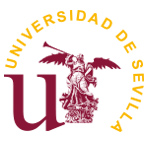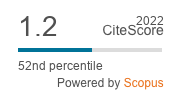Teaching-learning process perceptions with undergraduate students from COVID-19
DOI:
https://doi.org/10.12795/revistafuentes.2024.23562Keywords:
Emergency Remote Learning, Course Design, Higher Education, Virtual Environment, Dependent Samples, COVID-19 Pandemic, Learning Outcome, UniversityAbstract
Introduction. COVID-19 affected the teaching-learning process in universities. In general, there has been a shift from a face-to-face environment to an emergency remote environment (use of the Internet as a communication channel between professors and students). It is argued that most university courses will continue to be taught in a hybrid environment, although there is little literature on this subject, mainly in non-English speaking countries. This research aims to describe and explain factors affecting the level of university students' learning satisfaction in a face-to-face environment and an emergency remote environment. Method. 797 students' perceptions on Course Design and Teacher Interaction (CDI), Inter-student Interaction (SI), and Individual Learning (IL) were analyzed to explain Learning Outcomes (LO) in a Mexican University. The research design was dependent samples, students answered the same items considering both learning environments. Data analysis was performed through Exploratory Factor Analysis, paired means comparison, and multiple linear regression models. Results. Students preferred face-to-face environment to remote emergency environment. However, there are indications of a Learning Outcome associated with individual online learning. Conclusions. The findings contribute to the emergency remote education literature in Latin America context and stregthen instructional design. Specifically, the influence of the aforementioned factors in the two learning environments.
Downloads
References
Álvarez, H., Arias, E., Bergamaschi, A., López, Á., Noli, A., Ortiz, M., Pérez, M., Rieble-Aubourg, S., Rivera, M., Scannone, R., Vásquez, M., & Viteri, A. (2020). La educación en tiempos del coronavirus: Los sistemas educativos de América Latina y el Caribe ante COVID-19 (Número IDB-DP-00768). https://doi.org/10.18235/0002337
Amaya, A., Cantú Cervantes, D., & Marreros Vázquez, J. G. (2021). Análisis de las competencias didácticas virtuales en la impartición de clases universitarias en línea, durante contingencia del COVID-19. Revista de Educación a Distancia (RED), 21(65 SE-Artículos). https://doi.org/10.6018/red.426371
Arias, E., Dueñas, Z., Elacqua, G., Giambruno, C., Mateo, M., & Pérez, M. (2021). Hacia una educación 4.0: 10 módulos para la implementación de modelos híbridos: Vol. Serie IDB-.
Arias, E., Näslund-Hadley, E., Frisancho, V., & Vezza, E. (2022). Poniendo a la educación en su sitio. En ¿Cómo reconstruir la educación postpandemia?: soluciones para cumplir con la promesa de un mejor futuro para la juventud (pp. 173–245). Banco Interamericano de Desarrollo.
Becerra-Peña, D. L., & Rosales-Soto, A. (2022). Quantitative methods students’ perception during a pandemic : e-learning support and course satisfaction. Revista de Investigación en Tecnologías de la Información, 10(22), 81–91. https://doi.org/https://doi.org/10.36825/RITI.10.22.006
Borba, M. C., Askar, P., Engelbrecht, J., Gadanidis, G., Llinares, S., & Aguilar, M. S. (2016). Blended learning, e-learning and mobile learning in mathematics education. ZDM - Mathematics Education, 48(5), 589–610. https://doi.org/10.1007/s11858-016-0798-4
Borrayo Rodríguez, C., & Becerra Peña, D. L. (2023). Satisfacción estudiantil en el aprendizaje remoto de emergencia en la educación superior. En L. M. Ibarra Uribe & M. Guerrero Olvera (Eds.), Sociedad, gobierno y educación en tiempos de pandemia. Retos, satisfacción y calidad de vida (pp. 183–210). Universidad Autónoma del Estado de Morelos. https://doi.org/10.30973/2023/SOCIEDAD-PANDEMIA
Butz, N., & Stupnisky, R. (2016). A mixed methods study of graduate students’ self-determined motivation in synchronous hybrid learning environments. Internet and Higher Education, 28, 85–95. https://doi.org/10.1016/j.iheduc.2015.10.003
Chow, A. (2013). Synchronous and Asynchronous Interactions: Convenience and Content. En A. Sigal (Ed.), Advancing Library Education: Technological Innovation and Instructional Design (pp. 127–140). IGI Global. https://doi.org/10.4018/978-1-4666-3688-0.ch008
Costello, A. B., & Osborne, J. W. (2005). Best practices in exploratory factor analysis: Four recommendations for getting the most from your analysis. Practical Assessment, Research and Evaluation, 10(7). https://doi.org/10.7275/jyj1-4868
Curran, P. J., West, S. G., & Finch, J. F. (1996). The robustness of test statistics to nonnormality and specification error in confirmatory factor analysis. Psychological Methods, 1(1), 16–29. https://doi.org/10.1037/1082-989x.1.1.16
De Montreuil Carmona, L. J., & Irgang dos Santos, L. F. (2020). Challenges on teaching of Management through blended education. Revista Pensamento Contemporâneo em Administração, 14(1), 16. https://doi.org/10.12712/rpca.v14i1.40632
Dumford, A. D., & Miller, A. L. (2018). Online learning in higher education: exploring advantages and disadvantages for engagement. Journal of Computing in Higher Education, 30(3), 452–465. https://doi.org/10.1007/s12528-018-9179-z
Escueta, M., Nickow, A. J., Oreopoulos, P., & Quan, V. (2020). Upgrading education with technology: Insights from experimental research. Journal of Economic Literature, 58(4), 897–996. https://doi.org/10.1257/JEL.20191507
Evans, J. C., Yip, H., Chan, K., Armatas, C., & Tse, A. (2020). Blended learning in higher education: professional development in a Hong Kong university. Higher Education Research and Development, 39(4), 643–656. https://doi.org/10.1080/07294360.2019.1685943
Figueroa, H. (2022, marzo 12). La educación híbrida llegó para quedarse: UNAM. Excelsior. https://www.excelsior.com.mx/nacional/la-educacion-hibrida-llego-para-quedarse-unam/1503614
Fornell, C., & Larcker, D. F. (1981). Evaluating Structural Equation Models with Unobservable Variables and Measurement Error. Journal of Marketing Research, 18(1), 39–50. https://doi.org/10.2307/3151312
García, L. (2020). Bosque semántico: ¿educación/enseñanza/ aprendizaje a distancia , virtual , en línea , digital , eLearning …? RIED. Revista Iberoamericana de Educación a Distancia, 23(1), 9–28. https://doi.org/10.5944/ried.23.1.25495
Gómez, M., & Alemán, L. (2019). Modalidad b-learning: una estrategia para fortalecer la formación vocacional. Virtualidad, Educación y Ciencia, 10(18), 37–51.
Green, J. K., Burrow, M. S., & Carvalho, L. (2020). Designing for Transition: Supporting Teachers and Students Cope with Emergency Remote Education. Postdigital Science and Education, 2(3), 906–922. https://doi.org/10.1007/s42438-020-00185-6
Hair, J. F., Black, W. C., Babin, B. J., & Anderson, R. E. (2010). Multivariate Data Analysis (7th ed.). Pearson Prentice Hall.
Hinojo-Lucena, F. J., Trujillo-Torres, J. M., Marín-Marín, J. A., & Rodríguez-Jiménez, C. (2020). B-Learning in basic vocational training students for the Development of the Module of Applied Sciences I. Mathematics, 8(7), 1–13. https://doi.org/10.3390/math8071102
Hodges, C., Moore, S., Lockee, B., Trust, T., & Bond, A. (2020). The Difference Between Emergency Remote Teaching and Online Learning. Why IT Matters to Higher Education EDUCAUSE Review. https://er.educause.edu/articles/2020/3/the-difference-between-emergency-remote-teaching-and-online-learning
Hsiao, C. C., Huang, J. C. H., Huang, A. Y. Q., Lu, O. H. T., Yin, C. J., & Yang, S. J. H. (2019). Exploring the effects of online learning behaviors on short-term and long-term learning outcomes in flipped classrooms. Interactive Learning Environments, 27(8), 1160–1177. https://doi.org/10.1080/10494820.2018.1522651
Ibrahim, M. M., & Nat, M. (2019). Blended learning motivation model for instructors in higher education institutions. International Journal of Educational Technology in Higher Education, 16(12). https://doi.org/10.1186/s41239-019-0145-2
Keržič, D., Tomaževič, N., Aristovnik, A., & Umek, L. (2021). Predicting Students ’ Outcomes in Blended Learning : An Empirical Investigation in the Higher Education Context Predicting Students ’ Outcomes in Blended Learning : An Empirical Investigation in the Higher Education Context. Tehnički vjesnik, 28(1), 96–103. https://doi.org/10.17559/TV-20191019165025
Kline, R. (2011). Principles and Practice of Structural Equation Modeling. En Structural Equation Modeling (3rd ed., Vol. 25, Número 2). The Guilford Press.
Martínez, V. (2017). Educación presencial versus educación a distancia. La Cuestión Universitaria, 9, 108–116. http://webcast.berkeley.edu
Müller, C., & Mildenberger, T. (2021). Facilitating flexible learning by replacing classroom time with an online learning environment: A systematic review of blended learning in higher education. Educational Research Review, 34, 1–16. https://doi.org/10.1016/j.edurev.2021.100394
Niño Carrasco, S. A., Castellanos-Ramírez, J. C., & Patrón Espinosa, F. (2021). Contraste de experiencias de estudiantes universitarios en dos escenarios educativos: enseñanza en línea vs. enseñanza remota de emergencia. Revista de Educación a Distancia (RED), 21(65). https://doi.org/10.6018/red.440731
Oliveira, G., Grenha Teixeira, J., Torres, A., & Morais, C. (2021). An exploratory study on the emergency remote education experience of higher education students and teachers during the COVID-19 pandemic. British Journal of Educational Technology, 52(4), 1357–1376. https://doi.org/10.1111/bjet.13112
Otrel-Cass, K., Khoo, E., & Cowie, B. (2014). Networked Environments that Create Hybrid Spaces for Learning Science. E–Learning and Digital Media, 11(1), 88–104. https://doi.org/10.2304/elea.2014.11.1.88
Paechter, M., & Maier, B. (2010). Online or face-to-face? Students’ experiences and preferences in e-learning. Internet and Higher Education, 13(4), 292–297. https://doi.org/10.1016/j.iheduc.2010.09.004
Pattier, D., & Ferreira, P. D. (2023). ¿Presencial, online o híbrida?: Percepciones y preferencias por parte de docentes y estudiantes de educación superior. Revista Complutense de Educación, 34(1), 69–79. https://doi.org/10.5209/rced.76766
Peterson, R. A. (1994). A Meta-Analysis of Cronbach’s Coefficient Alpha. Journal of Consumer Research, 21(2), 381–391. http://www.jstor.org/stable/2489828
Peterson, R. A., & Kim, Y. (2013). On the relationship between coefficient alpha and composite reliability. The Journal of Applied Psychology, 98(1), 194–198. https://doi.org/10.1037/a0030767
Raes, A., Detienne, L., Windey, I., & Depaepe, F. (2020). A systematic literature review on synchronous hybrid learning: gaps identified. Learning Environments Research, 23(3), 269–290. https://doi.org/10.1007/s10984-019-09303-z
Rasheed, R. A., Kamsin, A., & Abdullah, N. A. (2020). Challenges in the online component of blended learning: A systematic review. Computers and Education, 144(March 2019), 103701. https://doi.org/10.1016/j.compedu.2019.103701
Salinas Ibáñez, J., de Benito Crosetti, B., Pérez Garcies, A., & Gisbert Cervera, M. (2018). Blended learning, más allá de la clase presencial. RIED. Revista Iberoamericana de Educación a Distancia, 21(1), 195–213. https://doi.org/10.5944/ried.21.1.18859
Sedaghatjou, M., Hughes, J., Liu, M., Ferrara, F., Howard, J., & Mammana, M. F. (2021). Teaching STEM online at the tertiary level during the COVID-19 pandemic. International Journal of Mathematical Education in Science and Technology. https://doi.org/10.1080/0020739X.2021.1954251
Simon Pallisé, J. S., Benedí González, C., Blanché Vergés, C., Bosch Daniel, M., & Torrado Fonseca, M. (2018). Análisis cuantitativo y cualitativo de la semipresencialidad del sistema universitario de Cataluña. Revista Iberoamericana de Educación a Distancia, 21(1), 113–133. https://doi.org/10.5944/ried.21.1.18773
Sukiman, Haningsih, S., & Rohmi, P. (2022). The pattern of hybrid learning to maintain learning effectiveness at the higher education level post-COVID-19 pandemic. European Journal of Educational Research, 11(1), 243–257. https://doi.org/10.12973/eu-jer.11.1.243
Topu, F. B., & Goktas, Y. (2019). The effects of guided-unguided learning in 3d virtual environment on students’ engagement and achievement. Computers in Human Behavior, 92, 1–10. https://doi.org/10.1016/j.chb.2018.10.022
Tseng, W.-T., Dörnyei, Z., & Schmitt, N. (2006). A New Approach to Assessing Strategic Learning: The Case of Self-Regulation in Vocabulary Acquisition. Applied Linguistics, 27(1), 78–102. https://doi.org/10.1093/applin/ami046
UNAM. (s/f). Educación remota de emergencia. https://recrea.cuaieed.unam.mx/glosario/Educación_remota_de_emergencia
Universidad de Guadalajara. (2020). Informe 2020. Rectoría General. https://rectoria.udg.mx/informe2020
Vallee, A., Blacher, J., Cariou, A., & Sorbets, E. (2020). Blended learning compared to traditional learning in medical education: Systematic review and meta-analysis. Journal of Medical Internet Research, 22(8), 1–19. https://doi.org/10.2196/16504
Veytia Bucheli, M. G., & Rodríguez Serrano, K. (2021). La retroalimentación efectiva en estudiantes desde la perspectiva de los docentes. Transdigital, 2(4), 1–23. https://doi.org/10.56162/transdigital63
Warren, L., Reilly, D., Herdan, A., & Lin, Y. (2021). Self-efficacy, performance and the role of blended learning. Journal of Applied Research in Higher Education, 13(1), 98–111. https://doi.org/10.1108/JARHE-08-2019-0210
Published
How to Cite
Issue
Section
License
Copyright (c) 2023 Filadelfo León-Cázares, Diana Lizette Becerra Peña, Carlos Iván Moreno-Arellano, Carmen Leticia Borrayo-Rodríguez

This work is licensed under a Creative Commons Attribution-NonCommercial-ShareAlike 4.0 International License.
Authors who publish in this journal accept the following conditions:
Authors conserve the copyrights and cede to the journal the right for first publication, with the work registered with the attribution licence of Creative Commons, which allows third parties to use the published work as long as they mention the authorship and the first publication in this journal.
The authors may make other independent and additional contractual agreements for the non-exclusive distribution of the version of the article published in this journal (e.g. include it an institutional repository or publish it in a book) as long as it clearly indicates that the work was first published in this journal.
Authors are allowed and indeed recommended to publish their work on the internet (for example on institutional or personal pages) before and during the revision and publication process, because it can lead to productive exchanges and greater and faster dissemination of the published work (see The Effect of Open Access).
Accepted 2023-10-20
Published 2024-01-15
- Abstract 718
- PDF (Español (España)) 413
- HTML (Español (España)) 146
- EPUB (Español (España)) 76














